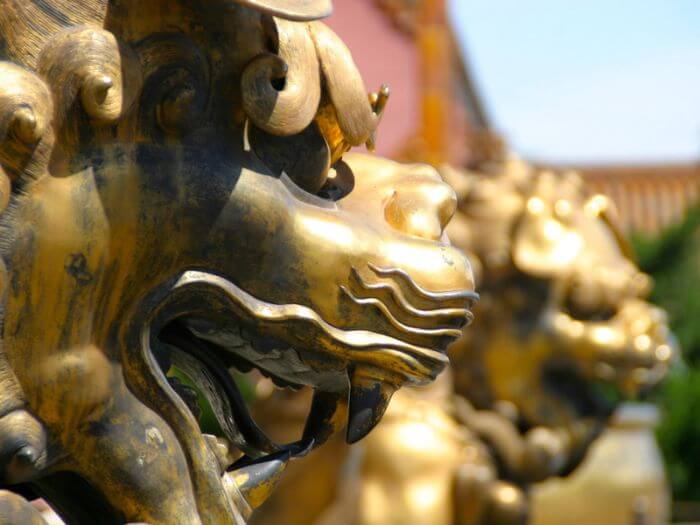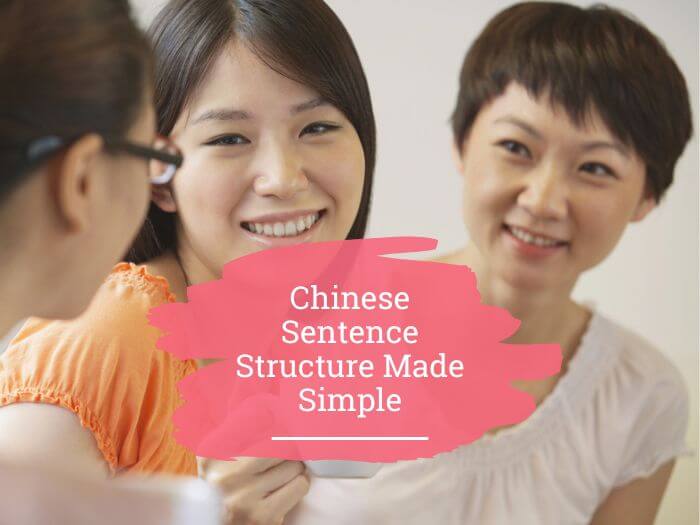Although learning Chinese presents several undeniable difficulties – like the writing system and the tones – learners of Chinese are often pleasantly surprised to find that many aspects of this language are, in fact, extremely simple.
That said, for native English speakers, Chinese sentence structure can seem quite alien and unnatural. And it’s something you need to get used to.
In general terms, the best advice is simply to accept things as they are and not to ask too many questions. If you are always asking “why”, you'll only confuse yourself. Instead, simply ask “how” to say something.
Besides, you'll pick up and integrate Chinese sentence structure as you immerse yourself in the language, whether that's by listening to Chinese or reading books.
So, to help you get to grips with Chinese sentence structure, in this post, I'll take you through some of the most common and useful constructions you will need to express basic ideas.
I’ll start with the simplest sentences and work up from there. That way, hopefully, you will be able to get a feel for how Chinese sentence structure works.
Pro Tip
By the way, if you want to learn Chinese fast and have fun, my top recommendation is Chinese Uncovered which teaches you through StoryLearning®.
With Chinese Uncovered you’ll use my unique StoryLearning® method to learn Chinese through story… not rules. It's the perfect way to internalise Chinese sentence structure to the point you know how it works instinctively.
If you’re ready to get started, click here for a 7-day FREE trial.
Table of Contents
Basic Chinese Sentence Structure
In Chinese, basic sentences follow the same subject-verb-object word order as English.
For example:
- 我爱你 wŏ ài nĭ (I love you)
- 你喜欢他 nĭ xĭhuan tā (you like him)
- 她在吃水果 tā zài chī shuĭguŏ (she is eating fruit)
In sentences where you have a direct object and an indirect object, the indirect object comes first, like this:
- 我教你中文 wŏ jiāo nĭ zhōngwén (I teach you Chinese)
- 老师给学生一个例子 lăoshī gĕi xuéshēng yí ge lìzi (The teacher gives the student an example)

Sentences With 给 Gĕi
In the second sentence above, the word 给 gĕi means “give”, and when used like this, it works just like in English.
However, this word has an important second use to express the sense of doing something for somebody. For example:
- 我给你讲一个故事 wŏ gĕi nĭ jiăng yí ge gùshì (I tell you a story)
- 我给你买了一本书 wŏ gĕi nĭ măi le yì bĕn shū (I bought you a book)
- 打给你电话 wŏ gĕi nĭ dă diàn huà (I phone you)
This is a very common structure in Chinese and one you should get used to using early on. Don’t try to translate word for word. Instead, just try to accept that this is how to say it in Chinese.
You might find the third one a little strange since there is no sense of doing anything “for” anybody. In that case, it’s probably best just to remember that this is the expression we use to express telephoning someone in Chinese and try not to worry about why we say it like this.
With these sentences, a different word order is also possible, like this:
- 我讲一个故事给你 wŏ jiăng yí ge gùshì gĕi nĭ (I tell you a story)
- 我买了一本书给你 wŏ măi le yì bĕn shū gĕi nĭ (I bought you a book)
- 我打电话给你 wŏ dă diàn huà gĕi nĭ (I phone you)
Chinese Sentence Structure With Adverbs

In simple sentences, most adverbs come before the verb, like this:
- 我很喜欢喝茶 wŏ hĕn xĭhuan hē chá (I like drinking tea)
- 我超级讨厌雨天 wŏ chāojí tăoyàn yŭtiān (I super-hate rainy days)
In the first sentence, the verb 喜欢 xĭhuan (to like, is preceded by 很 hĕn (very). In English, this wouldn’t make sense, but in Chinese, you literally say “I very like drinking tea”. This is why you will sometimes hear Chinese speakers use this word order in English.
The second one works better in English. 超级 chāojí means “super” and 讨厌 tăoyàn means “hate”, so you are literally saying “I super-hate rainy days” – and it sounds just as colloquial in Chinese as it does in English!
Sentence Structure With Chinese Adjectives
In Chinese, like in English, adjectives come before the noun they describe. For example:
- 冰啤酒 bīng píjiŭ (cold beer)
- 新房在 xīn fángzi (new house)
冰 bīng (cold) (literally “ice”, this is the word you use for a cold drink), and 新 xīn (new), are monosyllabic adjectives, so they are followed directly by the verb they describe.
However, for disyllabic adjectives (ones that have two syllables), you need to insert 的 de between the adjective and the noun, like this:
- 绿色的车 lǜsè de chē (green car)
- 漂亮的女孩儿 piàoliàng de nǚháir (beautiful girl)
In the first example, 绿色 lǜsè is the adjective meaning “green”, and it is separated from 车 chē (car), by 的 de. Note that 的 de doesn’t have any meaning here, it is just needed to make the sentence grammatically correct.
The second sentence works in the same way, with 的 de coming between 漂亮 piàoliàng (beautiful), and 女孩儿 nǚháir (girl).
If an adjective is modified by an adverb, 的 de is also required:
- 一只很大的狗 yì zhī hĕn dà de gŏu (a very big dog)
- 一个非常现代的建筑 yí ge fēicháng xiàndài de jiànzhù (an extremely modern building)
The adverbs 很 hĕn (very) and 非常 fēicháng (extremely) modify the adjectives 大 dà (big) and 现代 xiàndài (modern). This means you need to have 的 de before the noun otherwise the sentence will be incorrect.
Chinese Sentences Expressing “Degree”

I said above that in simple sentences, adverbs usually precede verbs. However, if you want to express the “degree” to which something is done, you have to use another structure.
For example, like this:
- 他说中文说得很流利 tā shuō zhōngwén shuō de hĕn liúlì (He speaks Chinese very fluently)
As you can see, the sentence structure and word order here is quite different from English. In effect, you have two parts to this sentence. In the first part, you say what he does, “speaks Chinese”, and then in the second part of the sentence, you repeat the verb and say how he does it.
Note also that in the second part, you add 得 de (which is different from the 的 de we saw above with adjectives) between the verb and the part that tells you how he does it. Again, this word doesn’t have any meaning in the sentence – it is there simply for grammatical reasons.
Here’s one more example:
- 他开车开得很好 tā kāi chē kāi de hĕn hăo (He drives very well)
Again, in the first half, you say what he does, literally “he drives car” – then in the second half, you say how he does it, “drives very well”.
Sometimes, a slightly different version is possible. For example, for the first example, you could also say it like this:
- 他中文说得很流利 tā zhōngwén shuō de hĕn liúlì (He speaks Chinese very fluently)
Here you introduce the topic of the sentence, “Chinese”, and then say how he speaks it – literally, the sentence is “he Chinese speaks very well”. However, this doesn’t always work; it would sound strange to use this version for the sentence about driving a car, for example.
Other variations on these patterns are possible, including with negative sentences and questions, although I don’t have space to talk more about them here – perhaps this is something I can come back to in a future post!
Question Words In Chinese

In Chinese, to turn a statement into a question, you just add the Chinese particle 吗 ma at the end of a sentence, like this:
- 你是英国人 nĭ shì yīngguórén (you are English)
- 你是英国人吗? nĭ shì yīngguórén ma? (are you English?)
However, if you want to use a question word, like “why”, “who” or “how”, the question word comes in the same place as the answer in the response.
For example:
- 你要什么? nĭ yào shénme? (what do you want?)
- 我要一瓶水 wŏ yào yì píng shuĭ (I want a bottle of water)
- 你是谁? nĭ shì shéi? (who are you?)
- 我是你父亲 wŏ shì nĭ fùqin (I am your father)
Look at the first example. In the response, the answer is 一瓶水 yì píng shuĭ (a bottle of water), which comes at the end of the sentence. This means the question word 什么 shénme (what), also comes at the end of the sentence.
In Chinese, you are literally saying “you want what?” – and the answer is “I want a bottle of water”. The second sentence works in the same way. Literally, you ask, “you are who?” – and you answer, “I am your father”.
Place Before Action…Usually
In Chinese, when you are talking about where something happens, the usual order is place before action.
For example:
- 我在北语学习中文 wŏ zài bĕiyŭ xuéxí zhōngwén (I study Chinese at BLCU)
- 我在一个公司工作 wŏ zài yí ge gōngsī gōngzuò (I work in a company)
In the first example, the place, Beijing Language and Culture University (BLCU, 北京语言大学 bĕijīng yŭyán dàxué, usually abbreviated to 北语 bĕiyŭ) comes before the action, studying Chinese.
In the second, the place where you work, “a company”, comes before what you do there (you work!).
However, there are some exceptions to this rule. When some words like 住 zhù (to live, inhabit), 坐 zuò (to sit) and 站 zhàn (to stand) are followed by 在 zài (at, be at), the action comes before the place, like this:
- 我住在上海 wŏ zhù zài Shànghăi (I live in Shanghai)
- 他坐在桌子上了 tā zuò zài zhuōzi shàng le (He sat on the table)
- 站在那儿吧! zhàn zài nàr ba! (Stand over there!)
Again, the best thing here is not to think about why we say it like this. Just remember that this is the correct way to say these sentences – and that’s enough!
Talking About “When” In Chinese

If you are talking about the time when something happens, the Chinese word order is time before action.
For example:
- 他明天要来 tā míngtiān yào lái (He will come tomorrow)
- 我去年已经去过 wŏ qùnián yĭjīng qùguo (I went before last year)
- 你昨天没看到吗? nĭ zuótiān méi kàn dào ma? (Didn’t you see yesterday?)
Notice that in these sentences, the subject usually comes at the start of the sentence. However, if you want to place more stress on the time, you can put the subject after the time expression, like this:
- 明天他要来 míngtiān tā yào lái (Tomorrow he will come)
This is less common, but it is also possible and places slightly more emphasis on when the action happens. However, you can’t place the time expression at the end of the sentence like in English – otherwise the sentence would be incorrect.
Talking About “How Long” In Chinese
On the other hand, if you want to talk about how long an action lasts, the time expression comes after the action in the sentence, like this:
- 她玩手机玩了两个小时 tā wán shŏujī wán le liăng ge xiăoshí (She played with her phone for two hours)
You will notice that this is a similar construction to sentences expressing “degree” – and that’s because grammatically, the sentences are essentially the same!
There is also another way to express the idea of “how long” – like this:
- 她玩两个小时的手机了 tā wán liăng ge xiăoshí de shŏujī le (She played with her phone for two hours)
Chinese Sentences With “Before”, “After” & “When”
Finally, in sentences with 以前 yĭqián (before), 以后 yĭhòu (after) and 的时候 de shíhou (when), the word order is basically the opposite of English.
In English, these time words come at the start of the sentence whereas, in Chinese, they always come at the end, like this:
- 我们见面的时候 women jiànmiàn de shíhou (When we meet (literally, “we meet when”))
- 她去重庆以前 tā qù Chóngqìng yĭqián (Before she goes/went to Chongqing (literally, “she goes/went to Chongqing before”))
- 离开中国以后 líkāi Zhōngguó yĭhòu (After leaving China (literally, “leaving China after”))
As you can see in all these examples, the time word is placed at the end of the sentence. However, even though this might seem a little strange at first, it’s not so difficult to get used to, and making sentences like this quickly becomes second nature.
FAQs About Chinese Sentence Structure
What is the basic sentence structure of Chinese?
The basic sentence structure in Chinese typically follows the Subject-Verb-Object (SVO) pattern. For example:
Subject (S): 我 (wǒ) – I
Verb (V): 吃 (chī) – eat
Object (O): 苹果 (píngguǒ) – apple
So, “I eat an apple” would be: 我吃苹果 (Wǒ chī píngguǒ).
Additionally, Chinese can include time and location elements, often placed at the beginning of the sentence. For example:
今天我去商店 (Jīntiān wǒ qù shāngdiàn) – “Today, I go to the store.”
Overall, the structure is flexible but usually adheres to the SVO order.
Is Chinese an svo or sov language?
Chinese is primarily an SVO (Subject-Verb-Object) language. This means that the typical sentence structure follows the order of subject first, followed by the verb, and then the object.
For example, in the sentence 我吃苹果 (Wǒ chī píngguǒ), which means “I eat an apple,” “I” is the subject, “eat” is the verb, and “apple” is the object.
Is Chinese sentence structure the same as English?
Yes, Chinese sentence structure is largely similar to English in that both typically follow the Subject-Verb-Object (SVO) order.
For example, the sentence “I eat an apple” translates to 我吃苹果 (Wǒ chī píngguǒ) in Chinese, maintaining the same structure.
However, there are differences in how additional elements like time and location are incorporated, which can lead to variations in more complex sentences.
Overall, the basic SVO structure is a commonality between the two languages.
To Learn Chinese Sentence Structure: Relax & Immerse Yourself

In this post, I have given you a brief overview of some of the most common basic sentence patterns in Chinese, although be aware that for each one, we could go a lot deeper. And many of these Chinese sentence structures deserve a whole post of their own.
As I mentioned at the beginning, my best advice when trying to learn Mandarin Chinese sentence structure is not to ask too many questions.
Don’t ask “why”, and instead, learn to accept them as they are. Then, once you start following these patterns and making sentences of your own, you will find that constructions that once seemed strange already feel much more natural.
In the meantime, to get Chinese sentence structure practice, as ever, follow the rules of StoryLearning and make daily contact with the Chinese language through story.
As you listen to and read stories in Chinese, try to notice the sentence structures that you've seen in this post. The more you're exposed to them, the more you'll get used to making sentences in Chinese the right way.
If you'd like my help mastering Chinese sentence structure fast why not try a FREE 7-day trial of Chinese Uncovered?
With Chinese Uncovered you’ll use my unique StoryLearning® method to learn Chinese sentence structure and other tricky Chinese grammar naturally through story… not rules.
It’s as fun as it is effective.
If you’re ready to get started, click here for a 7-day FREE trial.

Olly Richards
Creator of the StoryLearning® Method
Olly Richards is a renowned polyglot and language learning expert with over 15 years of experience teaching millions through his innovative StoryLearning® method. He is the creator of StoryLearning, one of the world's largest language learning blogs with 500,000+ monthly readers.
Olly has authored 30+ language learning books and courses, including the bestselling "Short Stories" series published by Teach Yourself.
When not developing new teaching methods, Richards practices what he preaches—he speaks 8 languages fluently and continues learning new ones through his own methodology.










































